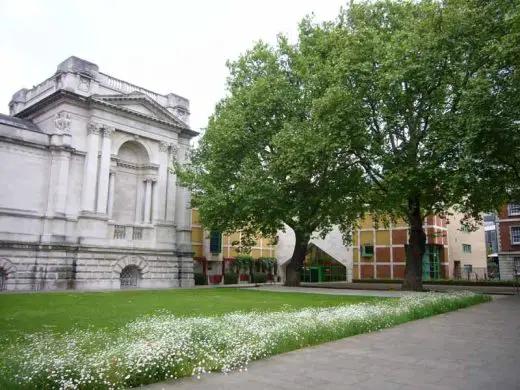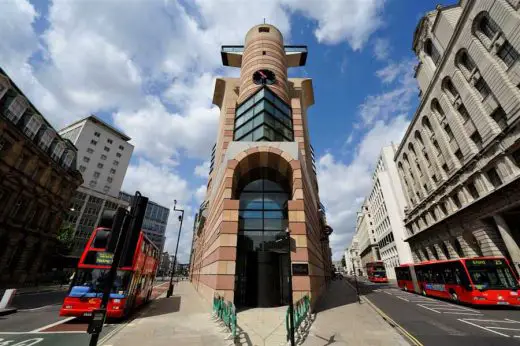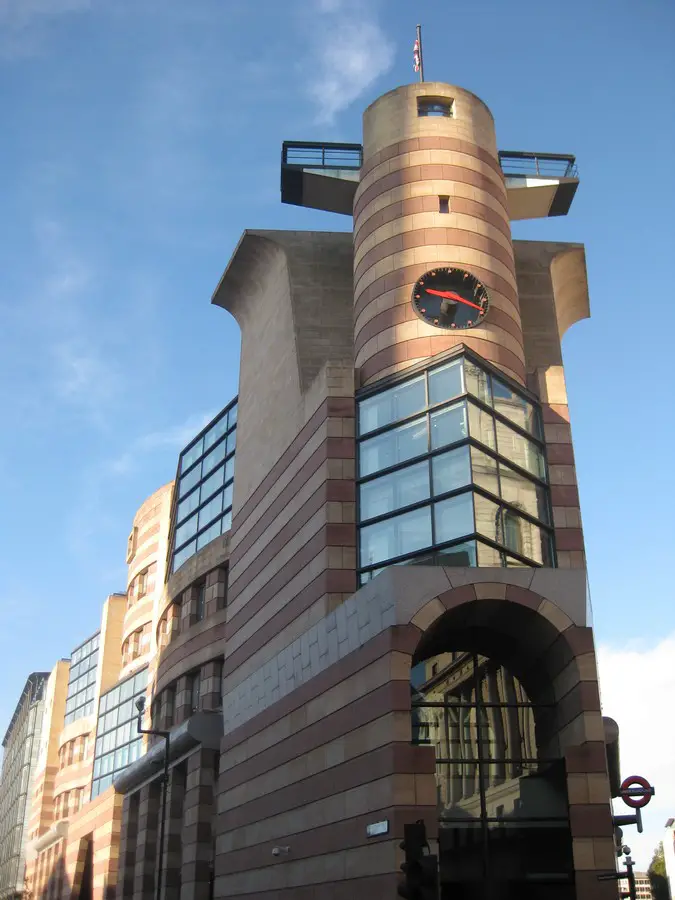Postmodern architecture images, PoMo architects designs, Property proposals news, Houses
Postmodern Buildings : Architecture
PoMo Buildings Designs – major International Built Environment projects and architects.
post updated 15 September 2024
Postmodernism straddled various disciplines from music to philosophy, from art to architecture. e-architect have selected what we feel are the key examples of Postmodern Architecture. PoMo buildings tended to be American though the UK also features quite strongly.
We aim to include Postmodern buildings / projects that are either of top quality or interesting, or ideally both.
We cover completed Postmodern buildings and architectural exhibitions.
Major PoMo buildings include the AT+T tower in New York City by architects Johnson/Burgee, the Clore Gallery and the Number 1 Poultry both by James Stirling Michael Wilford, and the Atlantis Condominium in Miami by Arquitectonica.
Postmodern architecture is a style or movement which emerged in the late 1950s as a reaction against the austerity, formality, and lack of variety of modern architecture, particularly in the international style advocated by Philip Johnson and Henry-Russell Hitchcock.
The movement was introduced by the architect and urban planner Denise Scott Brown and architectural theorist Robert Venturi in their 1972 book Learning from Las Vegas.
The style flourished from the 1980s through the 1990s. The key Pomo architects were Scott Brown & Venturi, Philip Johnson, Charles Moore and Michael Graves.
In the late 1990s, this architectural movement divided into high-tech architecture, neo-futurism, new classical architecture, and deconstructivism. However, some buildings built after this period are still considered Postmodern.
+++
Postmodern Architecture
Key Postmodernist Buildings, alphabetical:
550 Madison Avenue, New York City, NY 10022, USA
Date built: 1984
Architects: John Burgee, Philip Johnson
AT+T tower, Manhattan, NY, USA
Date built: 1984
Design: Johnson/Burgee
Infamous Postmodern building, criticised for being irreverent and simply a Modern building with a decorative top
The Atlantis Condominium, 2025 Brickell Avenue, Miami, Florida, USA
Dates built: 1980-1982
Design: Arquitectonica
More popular Postmodern building, a colourful apartment block with square hole cut out within the block, contianing a jacuzzi and palm tree. The Atlantis Condominium uses primary-coloured features applied to the roof and facade.
This Pomo building featured on the opening credits of the television series ‘Miami Vice’. It was also used as an exterior filming set in two episodes. This residential building contains 96 units.
Civic Centre in Chester-le-Street, County Durham, northeast England, UK
Date built: 1982
Design: Faulkner-Brown Hendy Watkinson and Stoner
Demolished
Clore Gallery, Tate Gallery, southeast London, England, UK
Dates built: 1980-85
Design: James Stirling Michael Wilford and Associates Ltd then Bain + Bevington Architects

photo © Adrian Welch
Clore Gallery Building
Tate Britain includes the Clore Gallery of 1987, designed by James Stirling, which houses work by J. M. W. Turner. The Clore Gallery has been regarded as an important example of Postmodern architecture, especially in the use of contextual irony: each section of the external facade quotes liberally from the building next to it in regard to materials and detailing.
Guild House, 711 Spring Garden St, Philadelphia, Pennsylvania, USA
Dates built: 1960-1963
Design: Robert Venturi
Guild House is a residential building in Philadelphia. The building was the first major work by Robert Venturi.
Along with the Vanna Venturi House it is considered to be one of the earliest expressions of Postmodern architecture. This US property design helped establish Robert Venturi as one of the leading architects of the 20th century.
The building was commissioned by a local Quaker organization, Friends Rehabilitation Program, Inc. It contains apartments for low-income senior citizens.
Guild House represented a conscious rejection of Modernist ideals. The architectural design used a combination of nondescript commercial architecture and ironic historical references.
Number 1 Poultry, City of London, England, UK
Date built: 1999
Design: James Stirling Michael Wilford and Associates Ltd completed as Michael Wilford and Partners Ltd

photograph © Nick Weall
Number 1 Poultry building
Highly controversial Postmodern building, criticised for its relationship with historic Mansion House buildings close by. The building was designed by James Stirling for a site which then was owned by developer Peter Palumbo, and first assembled by Palumbo’s father, Rudolph, in the 1960s.
After an attempt to add a Modernist office tower design by Ludwig Mies van der Rohe, a new design was created. It was Jim Stirling’s final design, in a postmodernist style with an outer shell of bands of rose-pink stone. The structure was built after his death. In 2016, following proposals to alter it, it received government recognition with a listing at grade II*, making it the youngest listed building in England.
One PPG Place, Pittsburgh, western Pennsylvania, USA
Date built: 1984
Design: Philip Johnson
Piazza D’Italia, Lafayette and Commerce Streets, downtown New Orleans, Louisiana, USA
Date built: 1978
Design: architect Charles Moore, with Perez Architects
Famous Postmodern design, more landscape than architecture. Deemed an architectural masterpiece even prior to its completion, the Piazza in fact began to rapidly deteriorate as the development surrounding it was never realized. By the turn of the new millennium, the Piazza d’Italia was largely unfrequented by and unknown to New Orleanians, and was sometimes referred to as the first “postmodern ruin”.
Portland Municipal Services Building, Portland, Oregon, USA
Date built: 1992
Design: Michael Graves Architects
American Postmodern building, like the AT&T essentially a rectilinear volume but in this case decorated on a large scale with colour stripes. The Portland Municipal Services Building was the third of three similarly Italianate buildings built in this city by local architect A.E. Doyle’s firm.
This pomo architecture project’s primary designer, Charles K. Greene, worked on the other Italianate Doyle-commissioned buildings in Portland: the smaller Bank of California Building (1924) and the Pacific Building (1926). Green initiated the design of this structure, but left Portland before the building was complete. Pietro Belluschi then completed the project.
Team Disney building, Burbank, California, USA
Date built: 1990
Design: Michael Graves Architect
Vanna Venturi House, Chestnut Hill, Philadelphia, Pennsylvania, USA
Dates built: 1962-1964
Design: Robert Venturi Architect
The Vanna Venturi House was designed by architect Robert Venturi for his mother, Vanna Venturi. The five-room house is only 30 feet (9 m) high, but has a monumental front facade.
Elements such as a non-structural applique arch and “hole in the wall” windows challenged Modernist orthodoxy, as described in Robert Venturi’s 1966 book Complexity and Contradiction in Architecture. Architectural historian Vincent Scully called it “the biggest small building of the second half of the twentieth century.”
More Postmodern Architecture online soon
Location: international
+++
Architectural Design
Postmodern Buildings in London
Wexner Center for the Visual Arts
Architects with Postmodern Links
Genre related to Postmodernism
Comments / photos for the Postmodern Architecture – PoMo Building images and news on the e-architect website page welcome.

